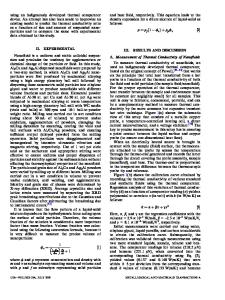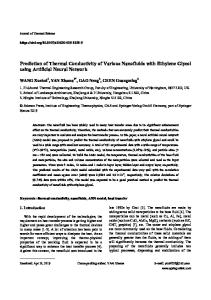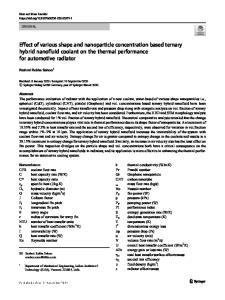The Effect of Nanoparticle Coating on the Thermal Conductivity of Nanofluids
- PDF / 235,121 Bytes
- 6 Pages / 612 x 792 pts (letter) Page_size
- 47 Downloads / 351 Views
1207-N07-05
The Effect of anoparticle Coating on the Thermal Conductivity of anofluids Michael J. Fornasiero and Diana-Andra Borca-Tasciuc* Mechanical, Aerospace and Nuclear Engineering Department Rensselaer Polytechnic Institute, Troy, NY 12180 U.S.A. ABSTRACT Nanofluids are engineered colloidal suspensions of nanometer-sized particles in a carrier fluid and are receiving significant attention because of their potential applications in heat transfer area. Theoretical and experimental investigations have shown that the enhanced thermal conductivity observed in nanofluids is due to nanoparticle clustering and networking. This provides a low resistance path to the heat flowing through the fluid. However, the surface coating of the nanoparticles, which is often used to provide stable dispersion over long term, may act as a thermal barrier, reducing the effective thermal conductivity of the nanofluid. Moreover, nanofluids with the same type/concentration of nanoparticles may exhibit different effective thermal conductivities, depending upon the thermal properties and thickness of the coating and the quality of the dispersion. In this context, thermal conductivity characterization of well dispersed iron oxide nanoparticles with two different surface coatings was carried out employing the transient hot wire technique. The diameter of the iron oxide core was 35 nm and the coatings used were aminosilane and carboxymethyl-dextran (CMX) of 7nm in thickness. Measured effective thermal conductivity was higher than predictions based on Maxwell theory, but much lower than that reported in literature for similar iron oxide nanofluids. This apparent discrepancy is thought to be primarily due to differences in nanoparticle coatings. I TRODUCTIO
Nanofluids, consisting of dispersed solid nanoparticles of diameter in the range of 1-50nm within a carrier fluid, have shown great promise as an exciting new class of heat transfer fluids [1]. Of particular interest is the effective thermal conductivity of nanofluids, which, in some conditions, greatly exceeds predictions based on models for composite media. References 1 and 2 are the latest reviews covering research on thermal conductivity of nanofluids [1,2]. A number of factors have been proposed to explain the anomalous increase in effective thermal conductivity of nanofluids [3-6]. Two primary mechanisms that are currently under consideration are nanoparticle motion [5], which is thought to produce local convective effects, and nanoparticle clustering and percollation, shown to provide a low resistance path to the heat flowing through the fluid [4]. However, if the later mechanism is responsible for the thermal conductivity enhancement, the surface coating of the nanoparticles, which is often used to provide stable dispersion over long term, may act as a thermal barrier, reducing the effective thermal conductivity of the nanofluid. Moreover, nanofluids with the same type of nanoparticles may exhibit different effective thermal conductivities, depending upon the thermal properties and
Data Loading...










